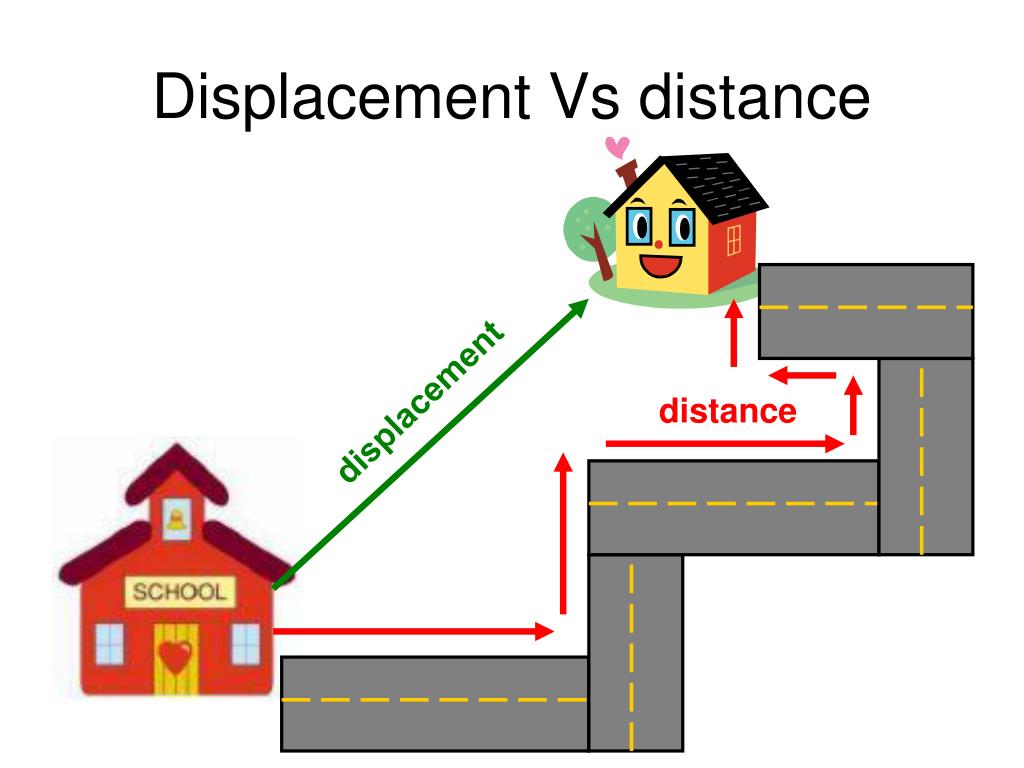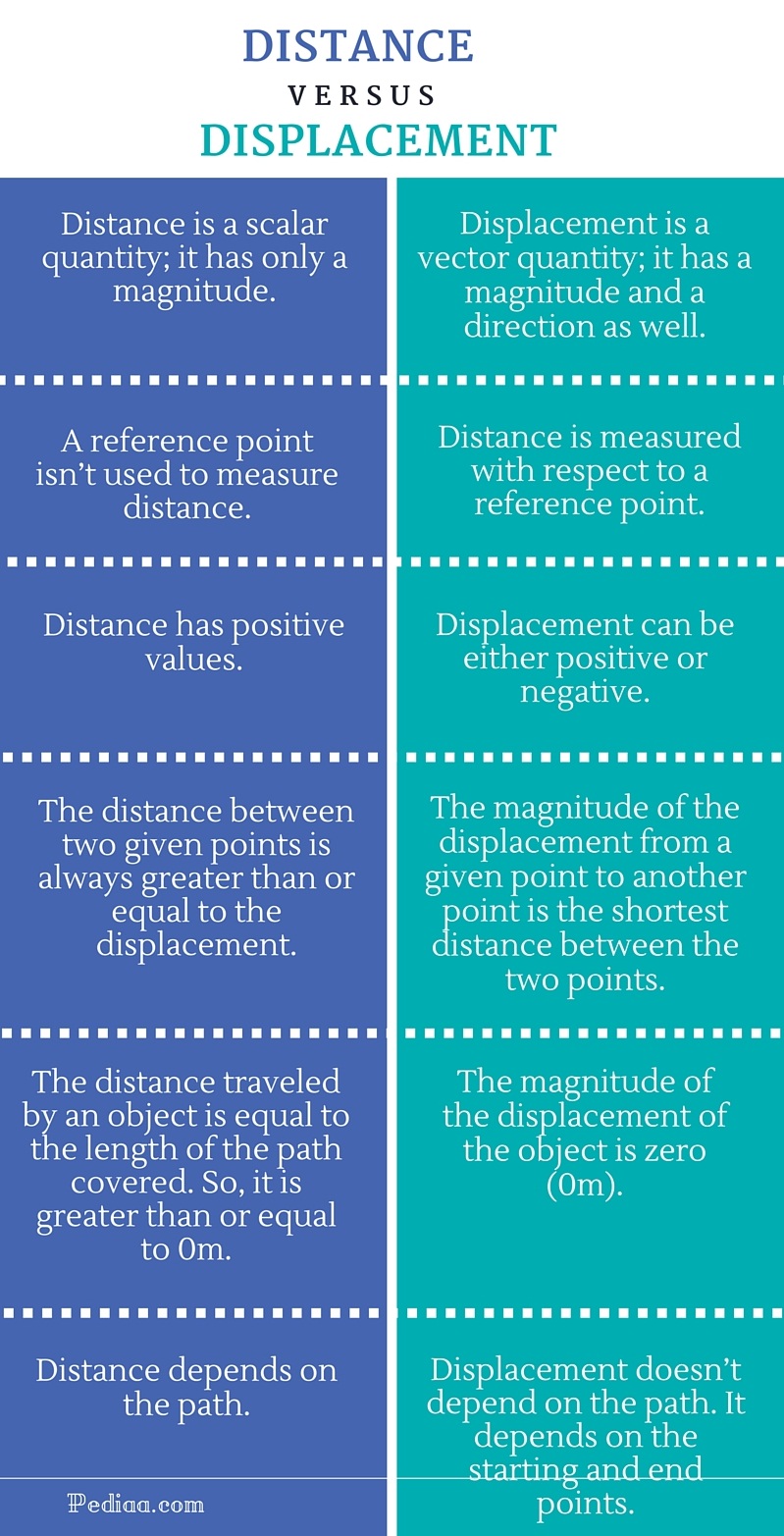Difference Between Distance And Displacement Pulptastic

Difference between Distance and Displacement Physics YouTube
Distance and displacement are commonly confused terms in physics that are important to get correct. Distance is a scalar quantity , the total distance traveled by an object; displacement is a vector quantity , the shortest path in a straight line between the starting position and final position. The difference between a vector quantity and a.

PPT Distance and Displacement PowerPoint Presentation, free download
The differences between Distance and Displacement are shown in the table added below, Distance . Displacement. Distance is the total path covered by the object in motion, irrespective of the direction of the path. Displacement is defined as the total change in the object's position along with the direction of motion.

PPT Unit 2D Motion Lesson Distance Vs Displacement PowerPoint
It is important to note the difference between distance traveled and displacement since, in general, they are different concepts that are often confused. Distance traveled is a scalar magnitude that is measured over the trajectory.Displacement is a vector magnitude that depends only on the initial and final position of the body and which is independent of the trajectory.

Difference Between Distance and Displacement
One way to think about this is to assume you marked the start of the motion and the end of the motion. The displacement is simply the difference in the position of the two marks and is independent of the path taken when traveling between the two marks. The distance traveled, however, is the total length of the path taken between the two marks.

PPT MOTION PowerPoint Presentation, free download ID5172910
4 years ago. Distance is the length of the path taken by an object whereas displacement is the simply the distance between where the object started and where it ended up. For example, lets say you drive a car. You drive it 5 miles east and then 3 miles west.

Difference Between Distance And Displacement Pulptastic
Distance and displacement are two quantities that may seem to mean the same thing yet have distinctly different definitions and meanings. Distance is a scalar quantity that refers to "how much ground an object has covered" during its motion.; Displacement is a vector quantity that refers to "how far out of place an object is"; it is the object's overall change in position.

Vector Illustration Difference Between Distance Displacement Stock
Distance: Displacement: 1: Definition: The complete length of the path between any two points is called distance. Displacement is the direct length between any two points when measured along the minimum path between them. 2: Denotation: d: s: 3: Direction Consideration: To calculate distance, the direction is not considered.

Difference between displacementdistance and displacementtime graph in
The distinction between distance and displacement is one of the most frequently questioned and perplexing problems in the field of physics. The major difference between distance and displacement is that distance is the length of a path between two points, while displacement is the shortest distance between two points. Although distance and displacement seem similar, they are different.

The Difference Between Distance & Displacement Introduction to
Summary. Distance refers to the total length traveled by an object, while displacement represents the change in position from the initial to the final point. Distance is a scalar quantity that considers magnitude, while displacement is a vector quantity that includes magnitude and direction. Distance doesn't consider direction or path, whereas.

Distance and Displacement (Scalars and Vectors) Teaching Resources
Answer link. Displacement is measured as the distance from a given point, while "distance" is just the total length traveled in a journey. One can also say that displacement is a vector as we often say that we have a displacement in x- direction or alike. For example, if I start at point A as a reference and move 50m east, and then 50m west.

631 Distance And Displacement Images, Stock Photos & Vectors Shutterstock
The amount of space between two points, measured along the minimum path which connects them, is called displacement. Distance is nothing but the length of the total route travelled by the object during motion. On the other hand, displacement is the least distance between starting and finishing point. Distance gives the complete information of.
Displacement Vs Distance NEW Classroom Math Poster eBay
We discuss the difference between distance and displacement and look at examples of what distinguishes them from one another in both one and two dimensions.F.

What Is The Difference Between Distance And Displacement A Plus Topper
Solution: Distance travelled by the body is. Distance = 2πr. Where r= radius of the body = 3km. Distance = 2 π 3 = 6π km. Displacement of the body is Zero because the body started from point A and came back to its initial position A.

Difference Between Distance and Displacement
Distance is a scalar quantity and displacement is a vector quantity. Distance has only magnitude. It measures the actual ground covered. Distance can only be positive. Displacement is measured with reference to a specific point. It is a straight line from the starting point (origin) to the end point. It is therefore also the shortest distance between two points. If the displacement vector is.

whats the difference between distance and displacement labview
Distance is considered to be a scalar quantity, while displacement is considered to be a vector quantity. Distance and displacement are two words related to the concept of motion in physics. The motion of an object can be defined quantitatively in terms of these two. Consider a person walking 2 miles to reach the same point at which he had.

What is difference between distance and displacement in Definition
Help students learn the difference between distance and displacement by showing examples of motion. As students watch, walk straight across the room and have students estimate the length of your path. Then, at same starting point, walk along a winding path to the same ending point. Again, have students estimate the length of your path.